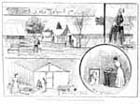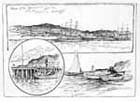Multimedia Content

Notes at the Typhoid Camp at the Alfred Hospital, 1 June 1889, courtesy of State Library of Victoria.
DetailsNurses with sick children, 1919, courtesy of Museum Victoria.
Details
Quarantine Station situated near Sorrento, 2 February 1891, courtesy of State Library of Victoria.
Details
The Small Pox in Melbourne, 3 September 1884, courtesy of State Library of Victoria.
Details
Yashmak Mask, 14 February 1919
Details
Diseases and Epidemics
Before the arrival of Europeans, with their suite of infectious diseases that had evolved in Eurasia, Australia was a 'virgin soil' society. The Kulin people suffered little communicable disease, first because they had not lived intimately with domesticated herd animals, and second because their low numbers provided insufficient hosts for infectious diseases to find a permanent ecological niche. Palaeopathological investigation has shown that the indigenous peoples who lived in the Murray region suffered more disease episodes, but these were likely to be diarrhoeal diseases resulting from their near-sedentary way of life in that food-rich environment. Similarly the semi-sedentary peoples of Western Victoria must have suffered more diarrhoeal disease than nomadic peoples in the more arid regions. The only infectious disease to thrive in Australian conditions had been Yaws and non-venereal syphilis, but Melbourne's climate was hostile to this earth-dwelling treponeme. Thus the Kulin did not possess cross-over immunity to venereal syphilis.
Every infectious disease that would afflict Melbourne's European settlers was imported, with the new arrivals creating the necessary ecologies for these old-world diseases to flourish in their new environment, but that was not how it looked to the first arrivals. Australia had been caught in a pincer movement between smallpox, which had been moving south-east through the Indonesia archipelago until it was brought to northern Australia by Macassan trepang fishermen, and the other old-world diseases that were being steadily introduced by European settlement. Smallpox immediately preceded the European settlement of Victoria, depopulating the densest Aboriginal communities along the Murray and through the Western District. Even earlier, whalers and sealers had introduced sexually transmitted diseases, most seriously for indigenous women and their fertility, gonorrhoea and chlamydia. Early settlers noted that many Aborigines were pock-marked but blamed a 'native pox'; others deplored their 'loathesome diseases', mistaking yaws for syphilis in the endemic treponeme regions and ignoring their own complicity in Aboriginal peoples' venereal infections. However, the adult Europeans who arrived in Australia were themselves hardy survivors of their disease-rich home ecologies. Nearly all would have been immune from smallpox, either by vaccination or early exposure.
The most consistent killer in early Melbourne, however, was diarrhoeal disease as the new settlers quickly set about befouling their immediate environment with human and domesticated animal waste. The ubiquitous Australian fly ensured that germs spread far and wide. Despite the healthful environment, infant mortality from gastro-enteritis and dysentery was to remain scandalously high throughout the 19th century. Melbourne's infant mortality rate would exceed that of London until the 1890s. 'Colonial fever' was soon a scourge but it would not be reliably diagnosed as typhoid until the 1870s. With overflowing cesspits, polluted rivers and creeks, open sewers in the city streets and casual use of pans, Smelbourne had a pervasive odour of human excrement. The growing typhoid death toll and the acceptance of germ theory by the 1890s finally impelled the sewering of Melbourne after 1897.
The long sea-voyage initially protected Australia from the common 'diseases of childhood' and it was not until the late 1830s that epidemic diseases broke out in Sydney with the high fatality rates to be expected from a native-born 'virgin' population. Measles was first brought to Victoria (and Australia) by the ship Persian in 1850, but it did not assume epidemic proportions until 1853-54. From then until 1900, measles came in sharp epidemics with high death rates between 50 and 200 per 100 000, the worst outbreak being in 1874-75. Measles' notorious debilitating effects on the immune system prepared the ground for Victoria's worst epidemic of scarlet fever in 1875-76 and for a rise in tuberculosis deaths over the next decade. Rapid urbanisation in Melbourne now provided sufficient hosts for these communicable diseases to become endemic. After 1900, death rates from measles stabilised. Scarlet fever's decline has been attributed in part to a biological variation in virulence. Although cholera was much feared, assiduous quarantine ensured that it never reached Australia.
Faster shipping ensured that Australia was no longer safe from influenza pandemics. Victoria's first outbreak was in 1860-61, but it did not achieve epidemic proportions until 1885. The 1890-91 'Russian influenza' struck hard, with doctors reporting widespread 'dispiritedness' in the Melbourne suburbs. Influenza was again epidemic in 1899, but the highest death rates were recorded in the 'Spanish Flu' pandemic of 1918-19, reaching 240 per 100 000 for Victoria in 1919, the highest death rate for any communicable disease in its history. Melbourne shared in the worldwide panic and temporary hospitals had to be opened in the Royal Exhibition Building and local schools.
Pulmonary tuberculosis brought many talented people to Australia, especially infected doctors, who otherwise might never have emigrated. If their own condition often improved in the gentler climate, they nonetheless passed on their infection to indigenous Australians and later to the unexposed native-born. Tuberculosis deaths in Victoria rose until the mid-1890s, whereupon they participated in the sharp decline that was subsequently recorded in most parts of the developed world. Death rates continued to fall during the 1930s depression and then fell away dramatically after the discovery of antibiotic therapy and compulsory chest screening.
The most feared of all epidemic diseases, bubonic plague, was brought to Sydney in January 1900, prompting a clean-up of Sydney's worst slums around the Rocks and rat-extermination programs throughout the country. Melbourne suffered 10 cases only in 1900, but the clean-up of living conditions conducted by municipal health officers focused public attention on the practices of boiling water and milk and controlling rodents. Smallpox was a problem for Europeans from infected ships and Melbourne's most significant outbreak was 56 cases in 1885-86. The opening of the Fairfield Infectious Diseases Hospital in 1904 provided isolation and expert care, in particular for children and adults suffering from diphtheria, poliomyelitis, scarlet fever and all other serious infectious diseases. Its final years of service were in the treatment and palliative care of terminal HIV/AIDS sufferers.
Acute anterior poliomyelitis presented Melbourne with its final significant epidemic disease before the arrival of HIV/AIDS. The outbreak in 1937-39 was particularly severe in Melbourne, causing the closure of schools and the banning of children from public transport. The higher susceptibility of the respectable was particularly alarming to a society now accustomed to disease accompanying poverty; the early exposure of poor children to the virus protected them from more damaging attacks later in life. For most communicable disease, however, the provision of a plentiful and clean water supply, sewerage, better diet and roomier housing, did much to mitigate the ravages of the biological baggage brought by the Europeans. Free immunisation provided by municipal government from the 1950s completed the conquest of the common diseases of childhood. Such interventions came far too late, however, to save the indigenous people, whose destruction by European disease was nothing less than catastrophic.
